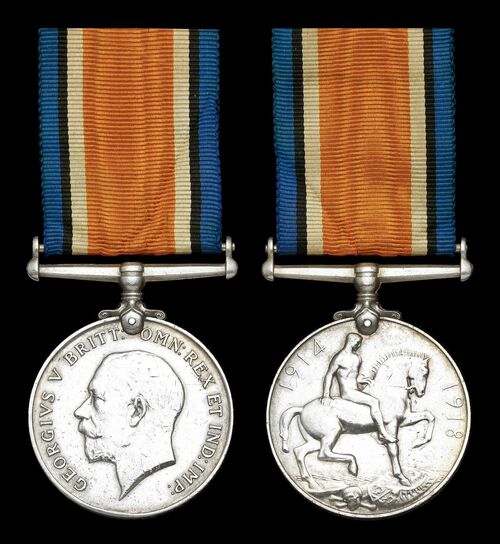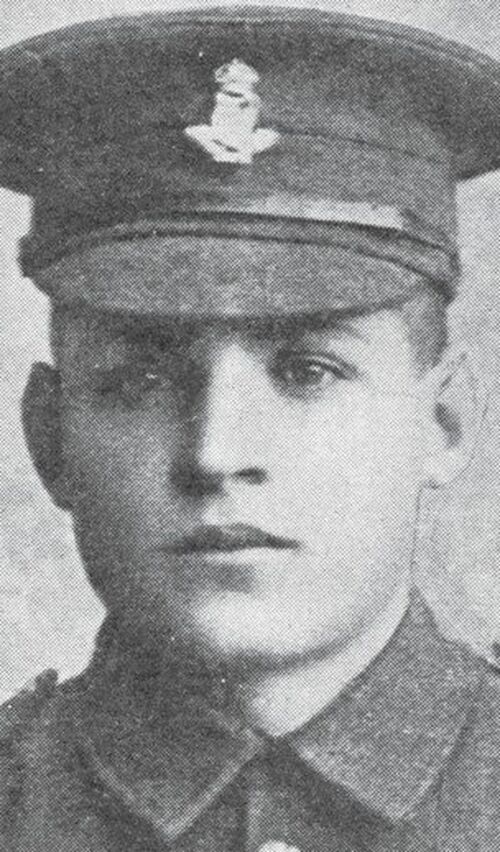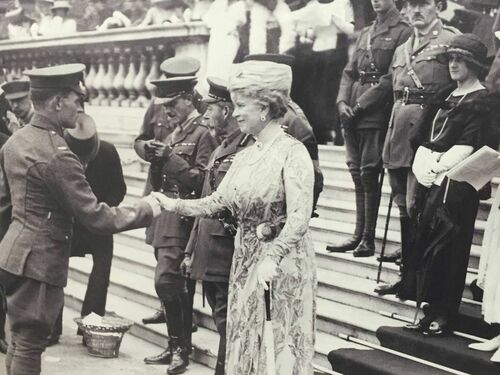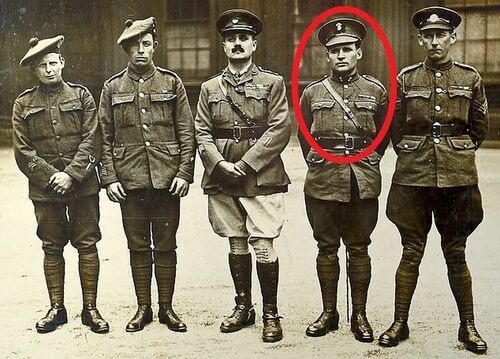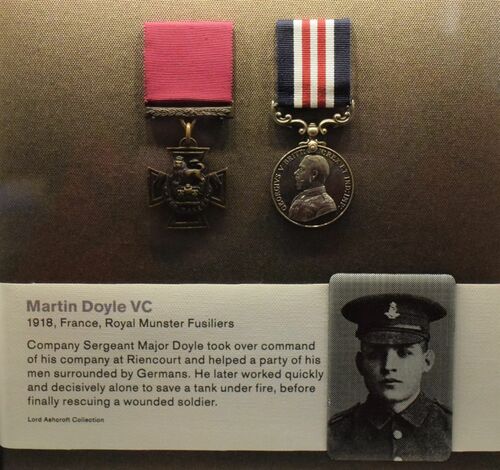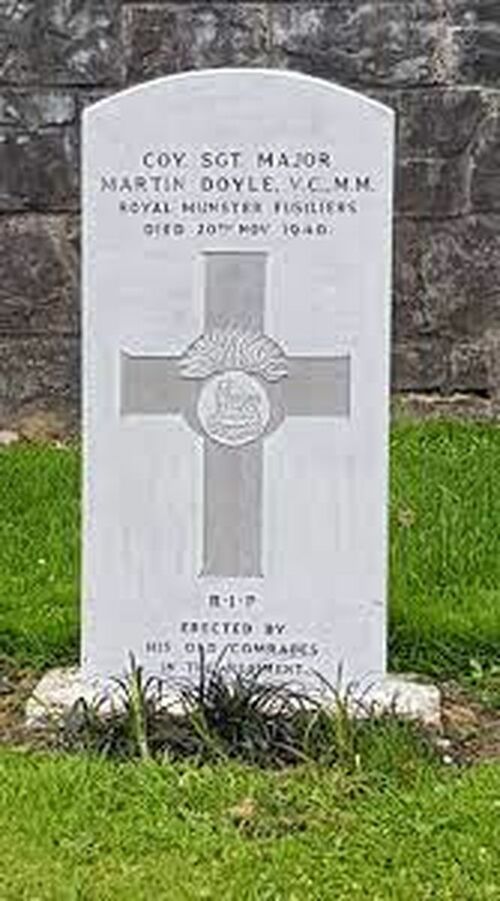Auction: 23113 - Orders, Decorations and Medals - e-Auction
Lot: 168
The historically important British War Medal awarded to Company Sergeant-Major M. Doyle, V.C., M.M., Royal Munster Fusiliers, Royal Irish Regiment and Royal Dublin Fusiliers, who latterly gained the unique distinction of having been the only recipient of the Victoria Cross to take up arms for the Irish Republican Army during the Irish War of Independence
British War Medal 1914-20 (9962 W.O.Cl.2. M. Doyle. R. Ir. Regt.), minor die flaw to rim, otherwise very fine
[V.C.] London Gazette 28 January 1919:
'For most conspicuous bravery on the 2nd September, 1918, near Riencourt, when as Acting Company Serjeant-Major, command of the company devolved upon him consequent on officer casualties.
Observing that some of our men were surrounded by the enemy, he led a party to their assistance, and by skill and leadership worked his way along the trenches, killed several of the enemy and extricated the party, carrying back, under heavy fire, a wounded officer to a place of safety. Later, seeing a Tank in difficulties, he rushed forward under intense fire, routed the enemy who were attempting to get into it, and prevented the advance of another enemy party collecting for a further attack on the Tank. An enemy machine gun now opened on the Tank at close range, rendering it impossible to get the wounded away, whereupon C.S.M. Doyle, with great gallantry, rushed forward, and, single-handed, silenced the machine gun, capturing it with three prisoners. He then carried a wounded man to safety under very heavy fire.
Later in the day, when the enemy counterattacked his position, he showed great power of command, driving back the enemy and capturing many prisoners. Throughout the whole of these operations C.S.M. Doyle set the very highest example to all ranks by his courage and total disregard of danger.'
[M.M.] London Gazette 10 September 1918.
Perhaps the best biography is offered by The Irish Times in November 2018:
'There are 623 graves for British military personnel in Grangegorman Military Cemetery in Dublin. Each headstone is identical to the other being, according to the old imperial measures, 30 inches (76 centimetres tall), 15 inches (38cm) wide and two inches (3.2 centimetres) thick. They are made of white Portland Stone.
The grave of Martin Doyle, tucked into a corner at the entrance of the graveyard, looks like all the rest, but it is not a real Commonwealth War Graves Commission headstone.
Its real provenance is in the inscription at the bottom - "erected by his old comrades in the regiment" - the regiment being the Royal Munster Fusiliers.
Martin Doyle, who was originally from New Ross, Co Wexford, died at the age of 45 in 1940 from polio.
During the first World War he won the Military Medal in March 1918 leading a bayonet charge on a fortified German barn in France.He then followed it up on September 2nd 1918 near Reincourt in France, when as a company sergeant he led a group of his men to safety, prevented German soldiers from storming a tank and then single-handedly rushed a machine-gun nest capturing three prisoners. His citation published in the London Gazette praised his “total disregard of danger”.
In June 1919, and still dressed in his Royal Munster Fusiliers uniform, he received the Victoria Cross from King George V at Buckingham Palace.
A month later he left the British army after nine years. In October 1920 he took up arms against Britain when he joined the IRA in East Clare acting as an intelligence officer.
Afterwards joined the National Army during the Civil War where he was shot in the hand by former colleagues in the IRA and remained on in the Irish Army.
In 1937, he applied to be compassionately discharged as he had been offered a job in Guinness, a company particularly well disposed to Irishmen who had served in the first World War.
His wife was sick at the time. For such a brave man physically, his fears over his family's health and financial stability are all over his correspondence with the Department of Defence.
“I have been very badly treated. Surely I deserve at least the same treatment as other ex British soldiers who served the cause in 1920 and 1921?” he wrote.
Privileges such as early discharge were afforded to those who could prove service in the IRA prior to the truce of July 1921. In order to qualify for early discharge, Doyle put together a list of testimonials from those he served with in the IRA.
One from Patrick McMahon stated that Doyle “worked and done everything possible for the IRA during the years 1920/1921”.
McMahon’s testimony would suggest that Doyle would have left the British army to “go to the hills” quicker, but was advised that he was more valuable in the British garrison in Ennis than out of it.
“I succeeded in convincing him that he was more useful inside the British Bks (sic) at the time notwithstanding that both of us were appreciative of his position which was looked upon with suspicion at the time”.
Doyle eventually succeeded in getting employment in Guinness. On Sunday he will be honoured by the British government, despite his service in the IRA, when a VC paving stone in his honour will be unveiled at Glasnevin Cemetery as part of the Armistice Day commemorations, commemorating the centenary of the end of the first World War. He will be remembered along with four other Irish VC winners.
Remarkably, his three daughters, Bridget, who is 98, Charlotte, who lives in the United States and Mary, who lives in Dublin, are still alive.
His great-grand nephew Leighton Thomas said Martin Doyle was buried as a British soldier at the request of his old comrades who paid for the headstone as the family were too poor at the time.
He also stressed that Doyle was an honourable man who served the army of Ireland as it was at the time, first the British army, then the IRA and finally the National/Irish army.
"Martin Doyle told a relative that he won the Victoria Cross for the wrong army," Mr Thomas said.
“Like a lot of Irishmen, he believed Ireland would get her freedom after the war. He was always trying to serve Ireland, not the British.”'
Doyle's Victoria Cross & Military Medal were sold in these rooms in June 1995, being purchased for the Lord Ashcroft Collection and now reside on public display at the Imperial War Museum, London. In December 2023, Lord Ashcroft published an article into his research into the group in The Daily Express:
'Victoria Cross recipients tend to lead adventurous lives both on and off the battlefield. However, few can have led such challenging and complex lives as Company Sergeant Major Martin Doyle. His irrefutable courage in the service of the Crown was honoured with the V.C.
But Doyle is a controversial recipient because, uniquely among his gallant peers, within a year of receiving his gong, he was fighting the very country that had bestowed the award upon him. Doyle, an Irishman, is the only recipient of our most prestigious award for bravery in the face of the enemy who is also known to have been a member of the Irish Republican Army...
His family, many of whom still live in New Ross, strongly refute suggestions he asked to be buried in his British Army uniform, stating categorically that he was laid to rest in a brown habit, then traditional Roman Catholic burial attire. They also dismiss rumours that while serving in the IRA he may have been a double agent for the British. They are convinced that, once he joined the IRA, his conversion to the Republican cause was genuine and lasting.
The fact that he was posthumously decorated by the Irish Government with the War of Independence medal suggests that this assessment is correct. I was assisted with my research by two members of Doyle’s family: Leighton Thomas, his great-great-nephew, an electrician from New Ross, and Padraig Ryan, his great-nephew, a storeman, who also lives in the town. Thomas campaigned successfully for a blue plaque, commissioned by Wexford County Council, to be placed outside Doyle’s former home in New Ross.
So, should there be separation between Doyle VC’s remarkable feats of bravery in defence of Britain and his subsequent, in the eyes of the crown, treacherous acts in the name of Irish independence? Or is it right his later exploits against Britain alter our perception and commemoration of this unique and controversial VC recipient? Doyle was for different reasons a hero to many, both in Britain and parts of Ireland.
But, while he saved British lives in the Great War, he was at least some part responsible for the probable deaths of others. It is undoubtedly a provocative and difficult case.
Most historians and observers distinguish between the early IRA that was fighting for independence and the Provisional IRA that became a terrorist group willing to blow up innocent civilians in its quest to end British rule in Northern Ireland.
The blue plaque, unlike his gravestone, lists his IRA service, stating clearly that he served in the British Army, Mid Clare IRA and the Irish Army. As great-great-nephew Leighton Thomas puts it: “Martin Doyle was a proud Irishman who would have liked to have won his Victoria Cross for Ireland but when the Great War started, Ireland did not exist.”'
Subject to 20% VAT on Buyer’s Premium. For more information please view Terms and Conditions for Buyers.
Sold for
£4,500
Starting price
£3000

